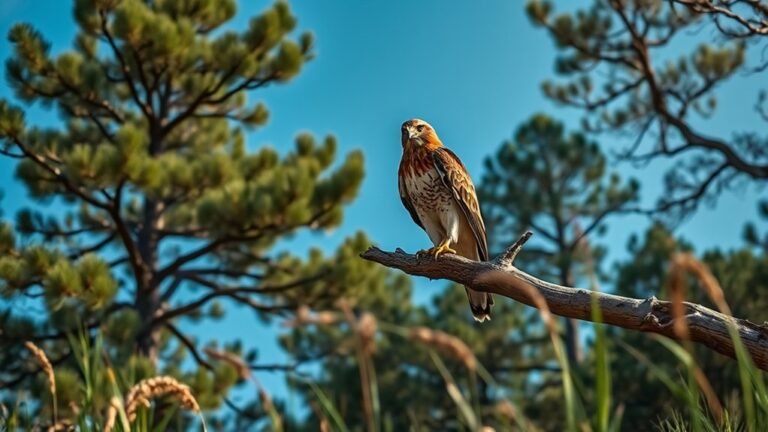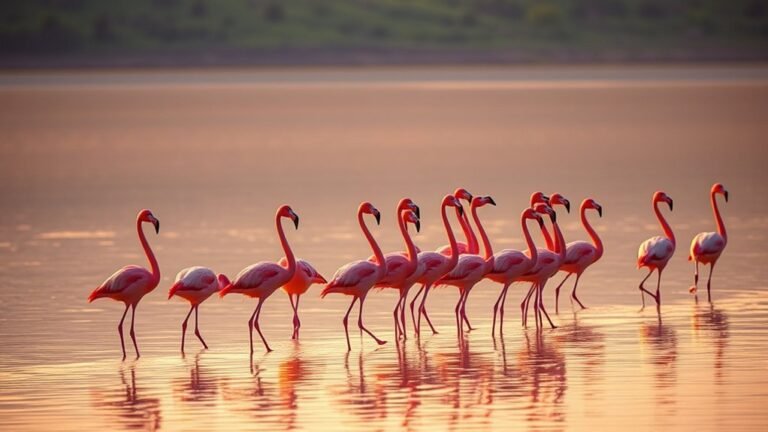Florida’s State Bird: Facts and Information
Florida's state bird is the mockingbird. This bird is known for its ability to adapt to different environments. Mockingbirds have gray and white feathers, making them easy to spot. They are also famous for their singing. These birds can mimic many sounds, from other birds to even human noises.
Mockingbirds play an important role in nature. They help control pests by eating insects. They also help plants by spreading seeds. This shows how much they contribute to the ecosystem.
What other fun facts do you want to know about these amazing birds?
A Quick Overview
The mockingbird is Florida's state bird. It is famous for its amazing ability to make sounds. This bird can copy over 200 different sounds!
Mockingbirds are about 10 to 11 inches long. They have pretty gray and white feathers that make them easy to spot.
These birds like to live in open spaces, parks, and wetlands. They can adapt to many different places.
Their diet is very varied. They eat insects, fruits, and seeds. By eating seeds and fruits, they help plant new plants!
The mockingbird represents creativity and adaptability. In stories, they are often seen as clever tricksters.
So next time you hear a mockingbird, remember how special this little bird is to Florida!
Overview of the Mockingbird

The Mockingbird is a special bird found in Florida. It's known for its amazing singing skills. This bird can copy the sounds of other birds and even some human noises. People in many cultures see the mockingbird as a symbol of creativity and being adaptable.
In some stories, the mockingbird is a trickster. This means it's clever and able to handle tough situations. Its songs connect people, showing how nature and stories can come together.
When you appreciate the mockingbird and its place in Florida's environment, you begin to see how it connects us all. This bird helps us feel like we belong to something bigger, sharing stories and enjoying nature together.
Physical Characteristics
The Mockingbird is a fascinating bird with a striking look. It usually measures about 10 to 11 inches long and has a wingspan of around 12 to 15 inches. You might see size differences among these birds depending on where they live.
Its feathers have a unique mix of gray and white that makes it stand out. Here are some key features to remember:
- Body Shape: The Mockingbird has a slender and quick body, which helps it move easily.
- Feathers: It has gray feathers on top, white on the bottom, and cool patterns on its wings.
- Eye Color: Its bright yellow eyes are very striking and add to its beauty.
These features make the Mockingbird not just beautiful, but also very adaptable to different places it lives.
Natural Habitat

Mockingbirds are birds that can live in many places. They like open areas and thick bushes. You can see them in different settings, like beaches or neighborhoods.
In cities, they enjoy parks and gardens where they can find food and places to build nests. They also like wetlands because these areas have lots of food for them.
Knowing where Mockingbirds live helps us understand how important they are. They help keep nature balanced by controlling pests and spreading seeds.
If you want to see more Mockingbirds, you can create friendly spaces for them in your yard or community. This can help you connect more with nature and the wildlife around you.
Vocal Abilities and Mimicry
Mockingbirds are famous for their great singing skills. They use their sounds for many important reasons.
Let's break it down simply:
- Imitating sounds: Mockingbirds can copy the calls of over 200 different birds. This shows how flexible they're with their voices.
- Making territory calls: Their songs help them mark their territory and attract mates. This is important for their breeding.
- Warning calls: They've special sounds to warn other birds about predators. This helps keep their friends safe.
These skills make mockingbirds important in nature.
When you learn about their singing, you can better enjoy and appreciate the world around you.
Behavior and Social Structure

Mockingbirds are interesting birds with unique behaviors that help them survive. They often live in groups and can be found in many different places. During breeding season, male mockingbirds are very protective of their territory. They use their songs and movements to show other birds that this area is theirs. This singing also helps attract females.
Mockingbirds are good at changing how they interact with each other based on their surroundings and what food is available. By observing these behaviors, we can see how important it's for individual mockingbirds and their groups to work well together.
This shows how all birds in nature are connected and depend on each other.
Diet and Feeding Habits
Mockingbirds are interesting birds that can adapt well to their surroundings. This includes what they eat. They're mostly omnivores, which means they eat both plants and animals. Here's what they like to eat:
- Insects: Mockingbirds love to find bugs like caterpillars and beetles. They hunt for these tasty snacks, especially when they're raising their young. These insects provide the protein that baby birds need to grow strong.
- Fruits and Berries: During certain seasons, mockingbirds enjoy fruits like berries. These fruits give them energy, helping them stay active and healthy.
- Seeds: Sometimes, mockingbirds also eat seeds. This shows how their diet changes depending on what food is around them.
This varied diet helps mockingbirds survive and thrive.
They also play an important role in nature by spreading seeds and nutrients while they eat.
Breeding and Nesting Practices
When springtime comes, mockingbirds start doing special things to find a place to live and to attract mates. The male mockingbirds sing many different songs. They like to perch high up on trees to show how lively they are.
As they pick their spot to live, they gather materials like twigs, grass, and leaves. These items help them build a strong nest in dense bushes or trees.
The female mockingbirds usually choose where the nest goes and help finish building it. They make sure it's safe from threats.
Once the nest is done, the couple spends time together to bond before they lay their eggs. After the eggs hatch, both parents work together to feed their babies. This shows how much they care for their young during this important time.
Cultural Significance in Florida
The mockingbird is an important part of Florida's culture. It represents ideas like being flexible and strong.
You can find mockingbirds in many stories, songs, and artworks that show their significance to the state. Here are three key ways mockingbirds are celebrated:
- Literature: Mockingbirds pop up in poems and stories. They often stand for freedom and the human spirit.
- Music: Many songs feature mockingbirds. They capture the lively sound of Florida's music scene.
- Art: Artists love to paint and draw mockingbirds. They highlight the beauty of these birds and their role in nature and local stories.
These representations help Floridians feel connected to their surroundings.
The mockingbird is a beloved symbol of Florida's identity.
Conservation Status
Mockingbirds are great birds that live in many places. But, they're facing some problems. Their homes are disappearing because of things like building cities, farming, and changes in the weather.
To help them, we need to work together. Protecting their homes is really important. When we save natural spaces and fix up damaged areas, we help mockingbirds thrive.
Getting involved in local conservation programs is a fun way to help. It not only protects these amazing birds but also brings people together in our communities.
When we do this work, we make sure future generations can enjoy the beautiful songs of mockingbirds. Their music brightens our lives and nature!
How to Spot a Mockingbird in the Wild
How can you spot a mockingbird in the wild? When you go birdwatching, keep an eye out for these simple clues:
- Color: Mockingbirds are mostly gray with white patches on their wings. Their colors help them blend in with nature.
- Movements: You might see them hopping on the ground or sitting on low branches. They're very active, so look for them moving around.
- Songs: Listen for their songs! Mockingbirds make a lot of different sounds and can even copy other birds. Their singing is a big part of who they are.
Remember these tips, and you'll have a better chance of finding a mockingbird next time you're outdoors!
Happy birdwatching!
Frequently Asked Questions
What Is the Mockingbird's Lifespan in the Wild?
Mockingbirds usually live for about 3 to 5 years in the wild. They sing loudly to mark their territory, which helps them stay safe. They eat different types of food, like bugs and fruits, which helps them do well in many places.
Are Mockingbirds Territorial During Breeding Season?
Yes, mockingbirds are very territorial during their breeding season. They protect their nests with great energy. When other birds come too close, mockingbirds often make loud sounds to scare them away. This behavior shows how important it is for them to keep their homes safe while raising their young. Understanding this can help you see how mockingbirds live and care for their families.
How Do Mockingbirds Adapt to Urban Environments?
Mockingbirds are great at living in cities. They find lots of different foods, like scraps and insects, which helps them survive.
These birds are also good at singing. They can mimic other sounds, like car alarms and dog barks, to communicate with each other. This helps them mark their territory, so they can find places to nest even with all the noise from humans around.
Thanks to their smart behaviors, mockingbirds can raise their young successfully in busy urban areas. They adapt well to their surroundings, which makes them a common sight in our neighborhoods.
Do Mockingbirds Migrate Seasonally?
Yes, mockingbirds do migrate based on the seasons. Some mockingbirds stay in the same area all year long, especially in places with mild weather. Others travel south when winter comes. They do this to find warmer weather and more food. Isn't that interesting?
What Predators Threaten the Mockingbird Population?
Mockingbirds face a few dangers in their lives. First, they are threatened by natural predators like cats and hawks. These animals can catch and eat mockingbirds.
Second, mockingbirds lose their homes because of urbanization. When people build cities and towns, they take away the places where mockingbirds can live and nest. This makes it harder for mockingbirds to survive and thrive in those areas.
It's important to understand these threats so we can help mockingbirds stay safe. By protecting their homes and keeping pets indoors, we can make a difference for these lovely birds.

Luna is the passionate founder and author of Birds and You, a website dedicated to sharing her love for birds with fellow enthusiasts. Through her engaging articles and guides, she aims to educate and inspire others to explore the fascinating world of birds. When she’s not writing, you can find Luna observing birds in their natural habitats or sharing beautiful bird photography on Pinterest. Join her on this journey to celebrate and protect our feathered friends!







